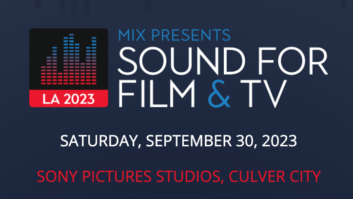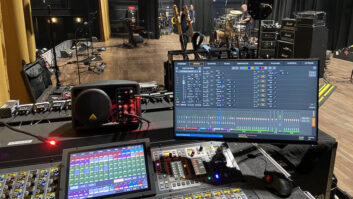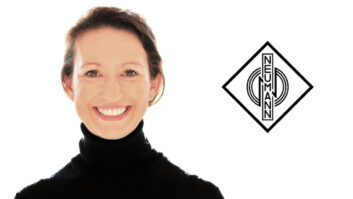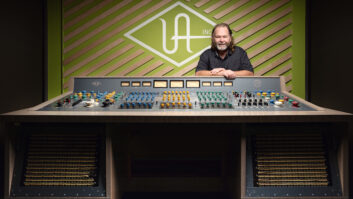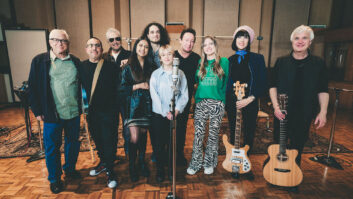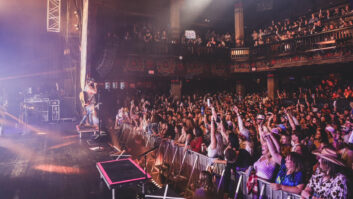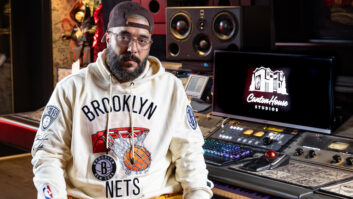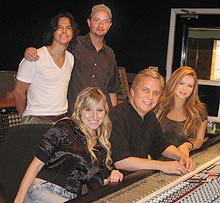
Standing: Producer Robin Diaz (left) and engineer Ian Blanch. Seated: Singer/songwriter Ashley Garland, studio owner/engineer Skip Saylor and co-owner/studio manager Lynn Carey Saylor.
Photo: Bud Scoppa
Skip’s Place, the tracking/mixing facility launched in mid-2007 by high-profile engineer/mixer Skip Saylor, is nestled in the rustic Valley neighborhood known as Sherwood Forest. Sitting on a ranch-style property off a quiet, tree-lined street, and centered around a barn that has been converted into a spacious tracking/mix room, the compound represents the realization of Saylor’s latter-day vision of an idyllic working environment. It feels like it’s a world away from Hollywood, where for 26 years Saylor played the dual roles of studio owner and master mixer before deciding it was time to seek out greener pastures — literally.
Three RVs, used as living quarters and chill-out lounges for clients, form a courtyard with the barn/studio, a lawn and a patio seating area under a canvas canopy; another canopy on the other side of the barn encloses a recreation area with a pool and ping-pong tables. This place has the airiest, most laid-back feel of any recording facility this side of Jim Guercio’s old Caribou Ranch in the Colorado Rockies — it’s certainly unlike any other recording setup I’ve visited in SoCal, including Saylor’s prior studios, his two-room facility in Larchmont and the three-room Devonshire.
Between them, the two previous studios drew such high-profile clients as Aretha Franklin, Guns N’ Roses, Foo Fighters, Manhattan Transfer, k.d. lang, Dr. Dre, Eminem and Snoop Dogg. During its first 14 months of operation, Saylor’s new facility has hosted a comparably diverse clientele, including Jonny Lang; the Goo Goo Dolls; Tantric; Mack 10; Candlebox’s Kevin Martin; producers Jay King, Israel Houghton and movie-music specialist Kevin Teasley; and mixers Toby Wright and Paul David Hager.
I arrive at midday, and Saylor, with whom I worked in the ’90s while doing A&R at Zoo, shows me around. “One of the things about being in Hollywood,” he says, “was there was no place to hide, have a meeting, take a shower. I came up with the idea of making this place more like a movie set — the movie companies have it down. And it really works. Sessions here actually go faster because of the relaxed vibe.”
Skip leads me into the control room, dominated by a 100-input SSL 4000G+, which he picked up in 2003. “We did a lot of work modifying this console, and it’s now the best-sounding console I’ve ever owned,” he says. “When something needs to be radically EQ’d, this is a great console for that.”
Sitting at the far-left of the board and firing up Pro Tools HD5 on the Mac is Ian Blanch, Saylor’s mixing partner for 12 years. The two are getting ready to start a session with producer Robin Diaz, who doubles as an in-demand drummer for hire (Chris Cornell, Hinder, 3 Doors Down). Their client is young writer/singer Ashley Garland. Diaz, who’s also working on his own project here, is psyched to be working with “Batman and Robin,” as Saylor laughingly refers to himself and Blanch. And he loves the atmosphere of the place.
“You come here and you immediately feel at home, surrounded by serenity,” says Diaz. “You have a barbecue, drink some Tecate, go record and it’s such a mellow way to work. And these guys know what they’re doing, obviously. So why go anywhere else?”
On the back wall are racks of gear Saylor has accumulated during the past three decades, including Lexicon, AMS and EMT reverbs; Pultec, Neve, API and Massenburg EQs; UREI, Empirical Labs and dbx compressor/limiters; and Saylor’s prized 27-frequency Bill Putnam graphic room EQs, which he uses as program EQs — as well as a Pro Control unit for premixing in Pro Tools. They mix to looming TAD mains, the requisite NS10s and a boombox.
Saylor and his wife, singer/songwriter and studio manager Lynn Carey Saylor, bought the 33,000-square-foot property in Northridge in 2003, moving from their home in Hancock Park into the ranch house that fronts the street. “It was really Lynn’s idea,” Saylor says. “She said, ‘Let’s get less house and more land.’ When we moved in, it felt good to step out the back door and see a horse ranch, though we never intended to get horses.
“We bought the property with the intention of doing something at some point, and after I sold Larchmont in June of ’06 and put the gear in storage, I went to New Zealand for two months to do a project,” he continues. “Getting away cleared my head, and I had fun for the first time in ages. At that point, I realized I’m an engineer/mixer, not a businessman. When I got back, I decided to put this place together.”
There was much work to be done at first, however, starting with the painstaking process of grading the property before defying logic by transforming a dilapidated barn into a functioning studio. “The process could’ve taken much longer,” says Saylor, but with two critical key people in his corner — his handyman of 16 years, Jorge Montiel, preparing the property and Vincent van Haaff protégé Lyle Ireland overseeing the construction and sound design — the transformation took just under eight months.
As Saylor walks me back to my car, he gazes at his creation and says, “Y’know, I don’t think I’ve ever been as content with who I am and what I’m doing as I am right now. Just look at this place — what else do you need?”
Send L.A. news to
[email protected].

